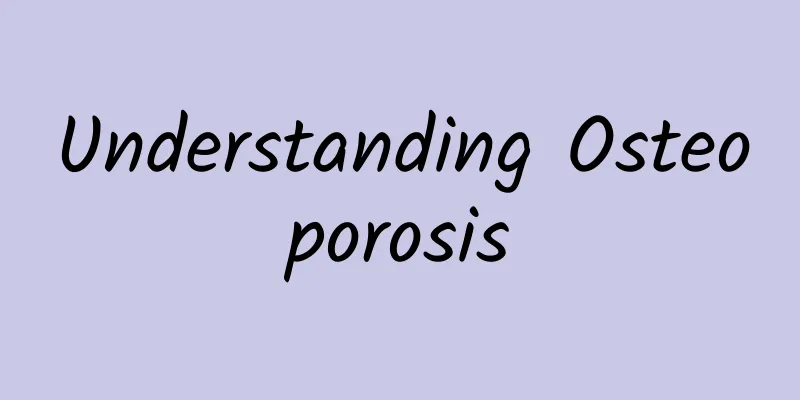Understanding Osteoporosis

|
1. What is osteoporosis? Osteoporosis is a systemic bone disease characterized by low bone mass and damaged bone microstructure, which leads to increased bone brittleness and easy fracture. Human bones are also in a continuous metabolic process, with bone absorption and bone formation working together to complete the replacement of old bones with new ones. However, once the coordination between bone absorption and bone formation is out of balance, bone absorption is greater than bone formation, and bone density will decrease, forming osteoporosis. 2. The harm of osteoporosis The most common symptom of osteoporosis is bone pain, the most common site of which is low back pain . In severe cases, pain may occur in multiple bones and joints throughout the body. However, the most serious hazard of osteoporosis is fractures , including but not limited to the thoracic spine, lumbar spine, hip joint, proximal radius, etc. Osteoporosis patients may also suffer from hunchbacks and decreased height. The high disability and mortality rates of osteoporotic fractures seriously affect the quality of life of patients, endanger their lives, and bring huge burdens to their families and society. 3. Epidemiology of osteoporosis As the aging of the Chinese population intensifies, the prevalence of osteoporosis has risen rapidly and has become an important public health issue. The national epidemiological survey on osteoporosis shows that the prevalence of osteoporosis in people over 50 years old is 19.2%, including 32.1% for women and 6.9% for men; the prevalence of osteoporosis in people over 65 years old is 32.0%, including 51.6% for women and 10.7% for men. The prevalence of vertebral fractures in women over 50 years old is about 15.0%, and the prevalence increases with age. The prevalence of vertebral fractures in women over 80 years old can be as high as 36.6%. Within one year after a hip fracture, 20% of patients may die from various complications, and about 50% of patients may become disabled. 4. Who is more likely to suffer from osteoporosis? Studies have found that osteoporosis is more likely to occur with age, postmenopausal women, and a family history of fragility fractures. In addition, unhealthy lifestyles: lack of physical activity, insufficient sunlight, smoking, excessive drinking, calcium and/or vitamin D deficiency, excessive consumption of caffeinated beverages, nutritional imbalance, excessive or insufficient protein intake, high-sodium diet, and low body weight can all lead to osteoporosis. In addition, patients with hypogonadism, diabetes, hyperthyroidism and other endocrine diseases, rheumatic immune diseases, gastrointestinal diseases, blood system diseases, neuromuscular diseases, chronic liver, kidney and cardiopulmonary diseases, etc., as well as the use of glucocorticoids, proton pump inhibitors, anti-epileptic drugs, aromatase inhibitors, gonadotropin-releasing hormone analogs, antiviral drugs, thiazolidinediones and excessive thyroid hormones are all risk factors for osteoporosis. 5. How to prevent osteoporosis This includes lifestyle adjustments and essential supplements for bone health. (1) Strengthen nutrition: Balanced diet: It is recommended to consume a balanced diet rich in calcium, low in salt and with an appropriate amount of protein. The recommended daily protein intake is 0.8-1.0 g/kg body weight, and 300 ml of milk or an equivalent amount of dairy products should be consumed every day . (2) Sufficient sunlight: It is recommended to expose the skin to the sun for 15 to 30 minutes as much as possible between 11:00 am and 15:00 pm, twice a week, to promote the synthesis of vitamin D in the body. Try not to apply sunscreen to avoid affecting the effect of sunlight. However, be careful to avoid strong sunlight to prevent skin burns. (3) Regular exercise: It is recommended to engage in physical exercise and rehabilitation therapy that are beneficial to bone health. Exercise can improve the body's agility, strength, posture, and balance, and reduce the risk of falls. Exercise can also help increase bone density. Exercise suitable for patients with osteoporosis includes weight-bearing exercise and resistance exercise. Regular weight-bearing and muscle strength exercises are recommended to reduce the risk of falls and fractures. Other exercises such as walking, jogging, Tai Chi, yoga, dancing, and table tennis are also acceptable. Exercise should be gradual and persistent. In addition, you should: quit smoking, limit alcohol consumption, avoid excessive coffee consumption, avoid excessive carbonated beverage consumption, and try to avoid or use less medications that affect bone metabolism. (The pictures in this article are from the Internet) Written by: Li Yue, Kunming Traditional Chinese Medicine Hospital Reviewer: Li Yinlong Typesetting: Li Shudong |
<<: To moisturize your skin, do you need to rely on facial masks?
>>: Popular Science | If a child has myopia in only one eye, does he need to not wear glasses?
Recommend
How many days does a girl's menstrual period last?
The number of days a girl's menstrual period ...
Do men who are "not good" need to nourish the kidneys and strengthen their virility? Get rid of misunderstandings and deal with male diseases scientifically
In ancient China, due to the low living standards...
What are the best ways to warm the uterus?
The uterus is a very important organ for women. I...
Causes of delayed menstruation due to endocrine disorders
I believe that many female friends will experienc...
Can severe pelvic inflammatory disease be cured?
If a woman's pelvic inflammatory disease is m...
What nutrients are lacking if your breasts are small?
Small breasts may be caused by a lack of vitamin ...
Girls can't sleep at night because of cold feet
The cold starts from the feet, which are the fart...
Treatment for breastfeeding mothers
Breastfeeding mothers should eat nutritious food ...
What is the normal thickness of the endometrium after menstruation?
A woman's uterus is the most important reprod...
Treatment for drooling during pregnancy
We all know that life is very difficult for every...
Princess Taiping's 6 major health crises
1. Susceptible to breast diseases Women with thin...
Is it worth dating a boyfriend who doesn't value holidays? What should I do if my boyfriend doesn't give me gifts on holidays?
The "sense of ritual" between lovers is...
Chicken eggs, duck eggs, quail eggs, which one is more nutritious? How to choose?
Chicken eggs, duck eggs, quail eggs... There are ...
Can a pregnant woman with hypothyroidism have a healthy baby?
If a pregnant woman suffers from hypothyroidism, ...









